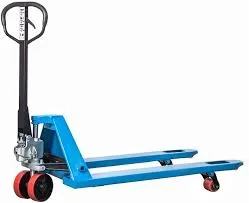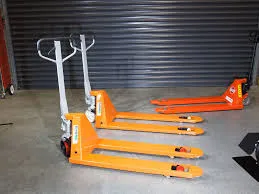In the bustling world of logistics and warehousing, equipment effectiveness can dramatically impact operational efficiency. A pallet power jack is one such equipment, revolutionizing the way warehouses move and handle heavy goods. With the demand for durability, efficiency, and safety on the rise in material handling, the choice of a pallet power jack can significantly influence workflow productivity. This article delves into the essentials of pallet power jacks, offering insights from real-world experience while discussing their benefits, technical specifications, and how they enhance supply chain operations.

The pallet power jack, commonly known as an electric pallet jack or powered pallet truck, is essentially a forklift's younger sibling.
It is designed for indoor use to transport pallets within a warehouse or store. Unlike manual pallet jacks that require physical effort to propel, a power jack uses an electric motor to lift and move loads, thus minimizing human strain and enhancing efficiency. These jacks are particularly advantageous in environments where the turnover of goods is high, and swift movement is crucial. By using a power jack, businesses can ensure quicker restocking, reduced employee fatigue, and lower risk of workplace injuries.
A notable advantage of the pallet power jack is its versatility. Unlike more extensive material handlers that require specialized training and licenses, power jacks are user-friendly and can be operated with minimal instruction. Their compact size allows them to navigate tight aisles and cramped spaces where larger machines cannot fit, making them ideal for small warehouses or retail environments. The ease of use and quick learning curve mean that businesses can deploy these devices with minimal downtime, an essential factor for high-paced operations.

From a technological standpoint, modern electric pallet jacks have advanced significantly. They come equipped with ergonomic controls designed for enhanced operator comfort and precision. The steering mechanism is generally intuitive, reducing the need for extensive training. Many models feature adjustable fork lengths and widths, making them suitable for different pallet sizes. Safety features are paramount expect built-in load stabilizers, anti-slip platforms, and automatic braking systems that prevent over-speeding, especially when navigating inclines or declines.
pallet power jack
Energy efficiency is a crucial consideration in the day-to-day operation of pallet power jacks. Today's models are typically powered by rechargeable lithium-ion batteries, which are renowned for their long service life and fast charging capabilities. This ensures that the jacks remain operational almost around the clock, a vital feature for demanding environments like cold storages or distribution centers. Routine charging and battery maintenance can lead to significant savings in energy costs and prolong the machine's lifespan, ensuring a reliable return on investment.
In my experience as a logistics consultant, selecting the right pallet power jack involves assessing the specific needs of your operation. Consider factors such as the weight of your typical loads, frequency of use, and the workspace environment. Understanding these elements will guide your choice between varying lift capacities and battery options. Partnering with reputable suppliers who offer robust after-sales support and warranty services can further enhance your trust in the equipment, ensuring minimal disruptions in case of malfunctions.
An authoritative supplier will also provide comprehensive training resources and maintenance tips, vital for the longevity and performance of the pallet power jack. Regular inspections and adherence to safety protocols should be a scheduled part of warehouse operations, reducing the risk of mechanical failures and ensuring a safe working environment.
In conclusion, a pallet power jack is an indispensable asset for any business that handles substantial volumes of goods. When chosen wisely and maintained correctly, it not only heightens productivity but also ensures worker safety and operational reliability. As technology evolves, future iterations of power jacks are likely to offer even greater features, possibly integrating IoT and automated controls for smarter and more efficient handling of goods. Embracing these advancements will be key for businesses keen on staying competitive in the logistics industry.








